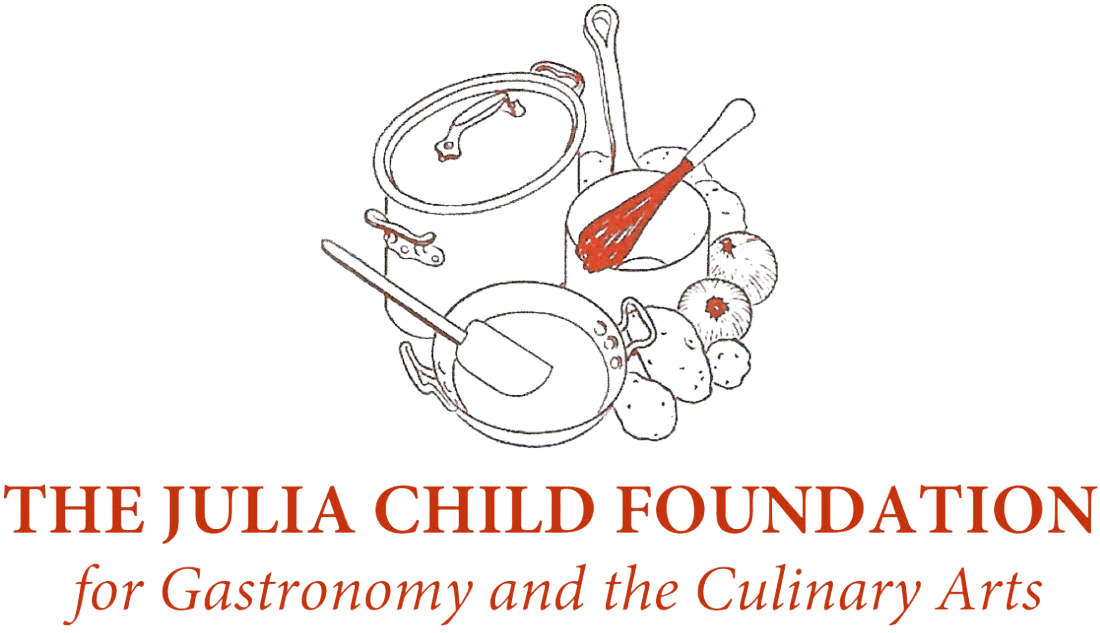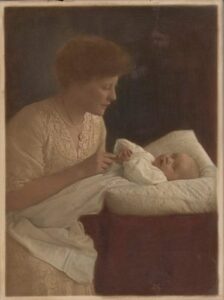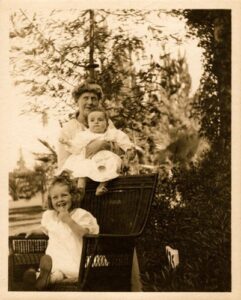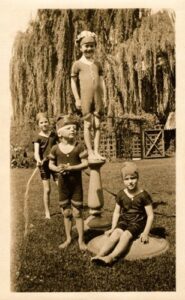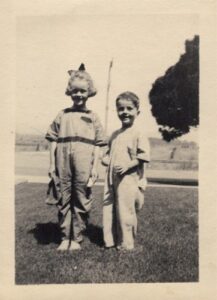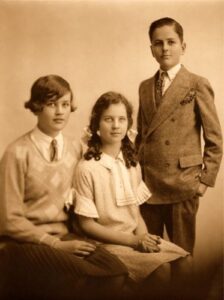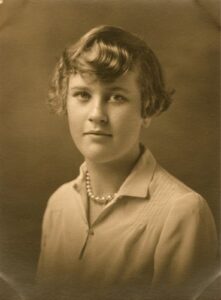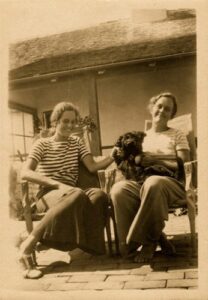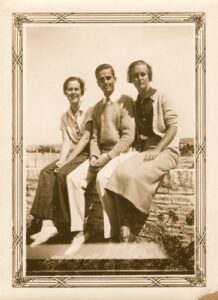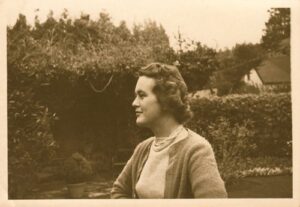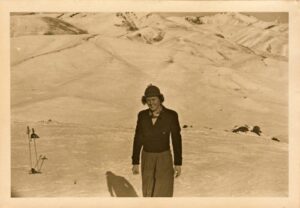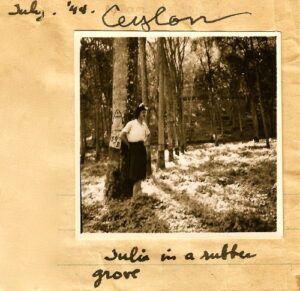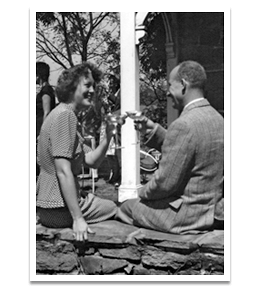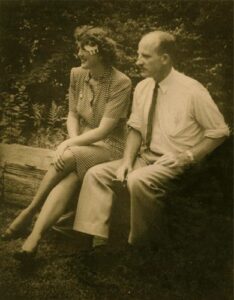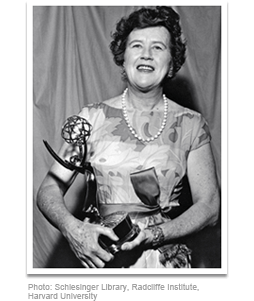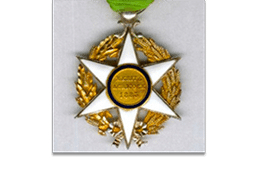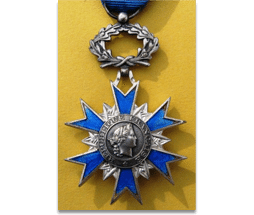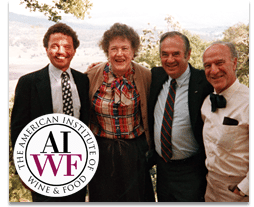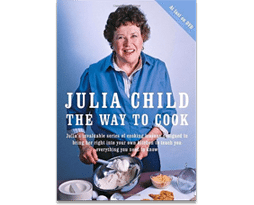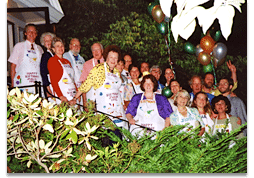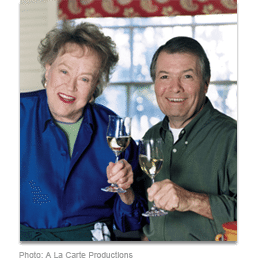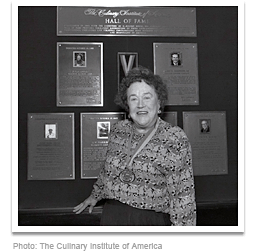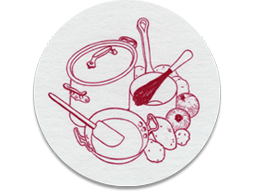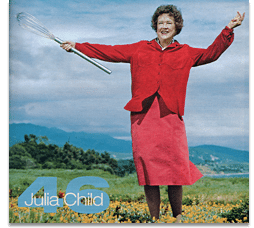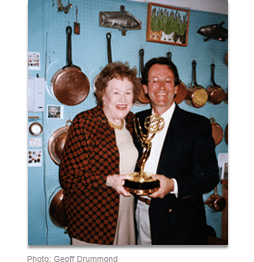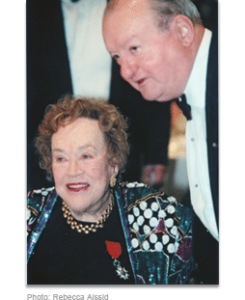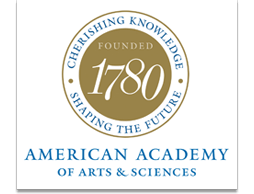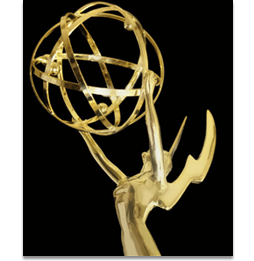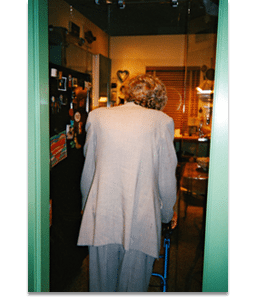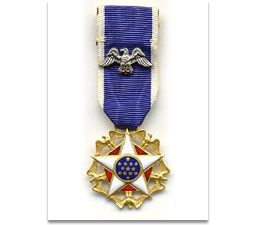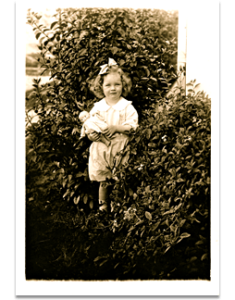-
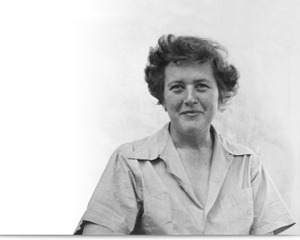
Julia’s Life and Work
Explore our timeline to learn about Julia’s life, career, and accomplishments, from her early years, growing up in California, to her time living in Paris, and learning to cook to her return to America, where she became one of the most influential voices in food. Use the arrows to move backward and forward, or navigate by year below.
-
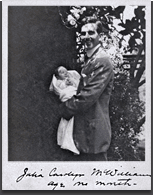
1912
Julia Carolyn McWilliams is born the eldest of three children in Pasadena, California. Julia’s father, John McWilliams, was a 1901 Princeton graduate who achieved a successful career in agricultural land management and real estate. Her mother, Julia Carolyn (Caro) Weston, Smith College class of 1900, was from Dalton, MA, the daughter of the founder of the Weston Paper Company, and a lieutenant governor of Massachusetts. Julia (6’3″ at her full height) is the eldest of three children about whom Caro would someday boast, “I have produced 18 feet of children.”
-
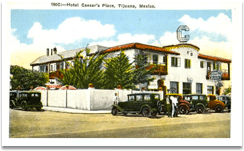
1925
Julia goes to Tijuana with her family, meets Caesar Cardini, and eats Caesar Salad. Julia writes about the experience in her book. “One of my early remembrances of restaurant life was going to Tijuana in 1925 or 1926 with my parents, who were wildly excited that they should finally lunch at Caesar’s restaurant. Tijuana, just south of the Mexican border from San Diego, was flourishing then, in the Prohibition era. Word spread about Tijuana and the good life, and about Caesar Cardini’s restaurant, and about Caesar’s salad.
-
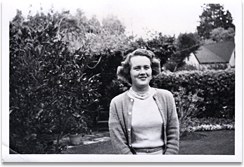
1934
A history major, Julia graduates from Smith College. “I was enrolled in Smith College at birth and eventually graduated from there in 1934 with a degree in history,” Julia wrote in her memoir, My Life in France. “At Smith I did some theater, a bit of creative writing, and played basketball. But I was a pure romantic, and only operating with half my burners on; I spent most of my time there just growing up.”
-
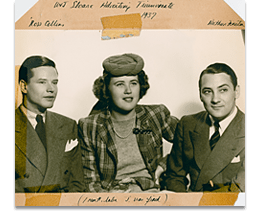
1935
Julia moves to Manhattan to pursue aspirations of becoming a writer. She finds a job working as a copywriter in the advertising department of an upscale home furnishings firm, W. & J. Sloane. “My plan after college was to become a famous woman novelist,” she wrote in My Life in France.
-
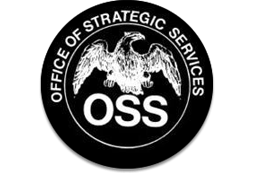
1942
Eager to help in her country’s efforts during World War II, Julia is hired as a typist for the U.S. Information Agency in Washington D.C. She is transferred to the Office of Strategic Services (OSS), the forerunner of the CIA, where she works directly with its leader, General William J. (Wild Bill) Donovan. She is first a research assistant in the Secret Intelligence division and later a researcher helping to develop shark repellent, a critical tool because sharks would sometimes set off the explosives intended for German U-boats. “I was too tall for the WACs and WAVES, but eventually joined the OSS, and set out into the world looking for adventure,” she writes in My Life in France.
-
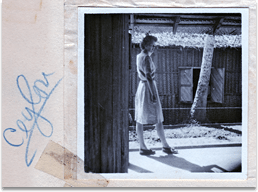
1944
Julia is posted to Ceylon (present day Sri Lanka) and later Kunming, China. Her responsibilities include handling highly classified information. According to the CIA, Julia ultimately served as Chief of the OSS Registry. Having top security clearances, Julia knew every incoming and outgoing message that passed through her office, as her Registry was serving all the intelligence branches. While in Ceylon she meets the older, worldly gourmet Paul Child, who had come down from Delhi, India to head the OSS’s Visual Presentation group.
-
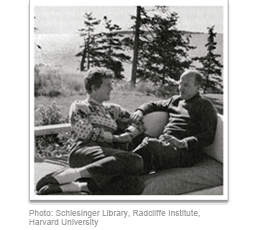
1945
Paul and Julia return to the U.S. and take a few months getting to know each other as civilians. Over the summer, they visit her father and stepmother in Pasadena, then drive across the country to visit Paul’s twin, Charlie, and his wife, Fredericka, in Maine. After a few days there, they announce their intention to marry. “It’s about time!” the family replies. While home, Julia enrolls in a Los Angeles cooking school to prepare for married life, though she’d later admit her early forays in the kitchen were disastrous. Paul is quoted as saying, “I was willing to put up with that awful cooking to get Julia.”
-
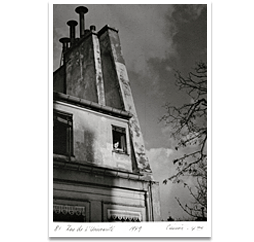
1948
Paul takes a position with the U.S. Foreign Service and they spend a year or so living in Washington D.C. before he is posted to Paris as part of the U.S. Information Service, attached to the American Embassy. Their move begins a six-year adventure living in Paris, Marseilles, Germany, and Norway. Julia’s first meal in France was at La Couronne restaurant in Rouen. She and Paul enjoyed Chablis, oysters, and Sole Meunière – a meal that she described as “the most exciting meal of my life.”
-
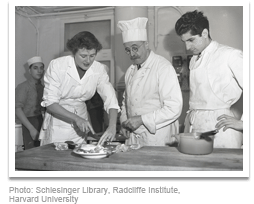
1949
Julia enrolls in the famed Parisian cooking school, Le Cordon Bleu. After a false start in a “housewife” level class, and deemed unqualified for a six-week haute cuisine course for experts, she is placed in a yearlong program for professional restaurateurs with eleven former GIs. Her instructor and mentor is chef Max Bugnard, who had worked with Auguste Escoffier in London. Under his tutelage, Julia thrives.
-
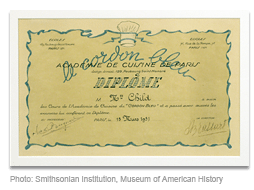
1951
Julia officially graduates from Le Cordon Bleu, having failed her first exam in 1950; pursuing her dream of making a career out of cooking (a dream she described as “a bit sketchy on the details”) meant re-taking the exam, which she did in April 1951. When Julia eventually received her diploma from the school, it was backdated to March 15, 1951.
-
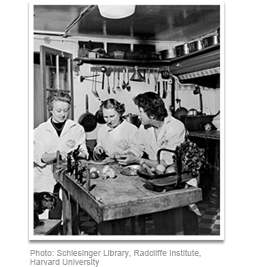
1952
Julia is introduced to two French women, Simone (Simca) Beck and Louisette Bertholle, who are working together on a cookbook about French cooking for Americans and seeking an American collaborator. Soon after their meeting, the three women open a cooking school, L’Ecole des Trois Gourmandes (charging $5 per lesson), and begin working together on their book.
-
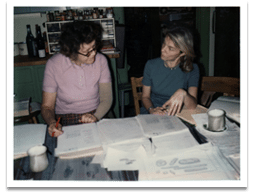
1958
With the help of friend Avis DeVoto – a well-connected former cookbook editor at Houghton Mifflin – Julia and her co-authors submit their 850-page manuscript, the result of seven years of collaboration, and their concept of multiple volumes to Houghton Mifflin, who find it to be too long and difficult to understand. After a major revision and a reduction to 684 pages, Houghton Mifflin again rejects the book. The manuscript eventually lands on the desk of Judith Jones, a young editor at Alfred A. Knopf, who strongly advocates taking a chance on the book. This marks the beginning of a long and fruitful collaboration.
-
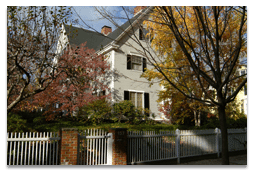
1961
Deciding to return to their native land, family and friends, Paul retires from public service. Julia and Paul settle into 103 Irving Street in Cambridge, MA, where Julia lived until she moved permanently to Montecito, CA in 2001. One of their first improvements is to redo the kitchen, which Paul designs.
-
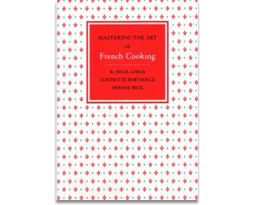
1961
October – After nine years researching, writing, recipe testing, and editing, Mastering the Art of French Cooking, Volume One is published.
-
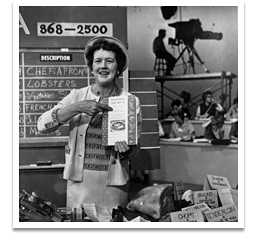
1962
Mastering the Art of French Cooking is named a Book-of-the-Month Club Selection; 12,000 copies are distributed. Enthusiasm for the book has continued through the years—nearly 3,500,00 copies of Mastering the Art of French Cooking, Volumes I and II have been sold to date. In September 2009, following the release of Sony Pictures’ Julia & Julia, over 300,000 copies are sold in one month alone. The e-book edition of Mastering the Art of French Cooking is released in October, 2011. -
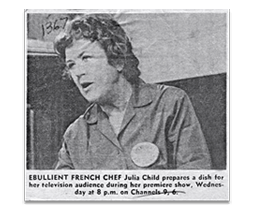
1963
February 11 – Julia’s interview promoting Mastering on the TV show “I’ve Been Reading” – produced by Boston’s public television station WGBH – launches her TV career. Having arrived with eggs, a whisk, and a copper bowl, Julia beats some egg whites “to enliven the talk.” Twenty-seven viewers write to the station, wanting to see more. The station produced three pilots, and then launched into production of The French Chef, which aired locally in 1962. The show debuted nationally in February, 1963 and aired until 1973.
-
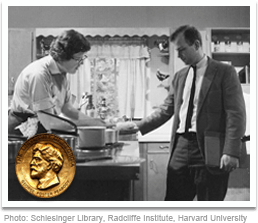
1964
Having teamed up with director/co-producer Russ Morash at WGBH, Julia wins the George Foster Peabody Award for distinguished achievement in television for The French Chef. Over the course of her career, Julia filmed more than 350 episodes of TV. About The French Chef TV series, excerpted from The French Chef Cookbook by Julia Child.
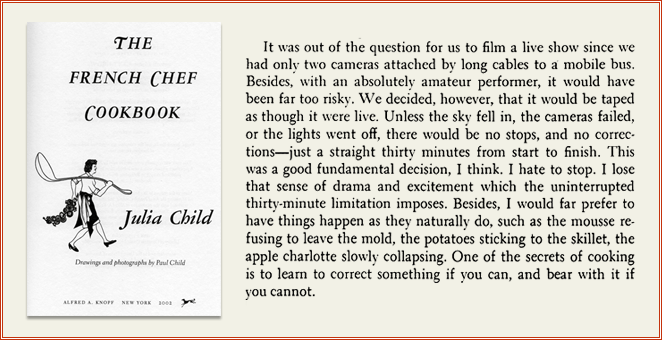
-
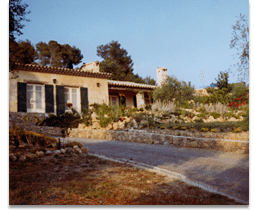
1965
Christmas 1965 marks Julia and Paul’s first visit to their home in Provence, built on property belonging to Simca and her husband, Jean Fischbacher. They call it “La Pitchoune,” a Provencal word meaning the “little one.” Soon it affectionately becomes referred to as “La Peetch.” Julia would keep the house until 1992.
-
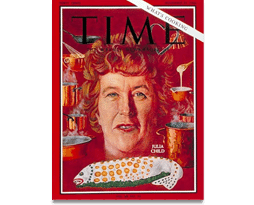
1966
Julia is on the cover of Time magazine, which dubs her “Our Lady of the Ladle.” The feature story describes Julia as the 54-year old, 6-ft.-2-inch tall star of The French Chef, whose “viewers on 104 educational TV stations across the U.S. watch her every move, forgive her every gaffe, and in a word, adore her. Manhattan matrons refuse to dine out the night she is on. When Washington D.C.’s WETA interrupted her program to carry Lyndon Johnson live, the station’s switchboard was jammed for an hour.”
-
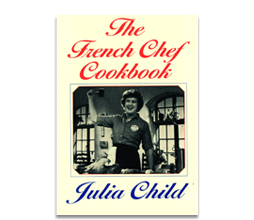
1968
Julia’s second book, The French Chef Cookbook, a compilation of the recipes from 119 programs of the first TV series, is published. The recipes appear in the order in which the shows were produced, beginning with the fourteenth show. “This is because the first thirteen shows no longer exist,” Julia explains in the book’s introduction. “When we started, The French Chef was purely a local New England program, and before WGBH-TV realized duplicates were needed to serve other educational stations throughout the country the first thirteen tapes had worn out…”
-
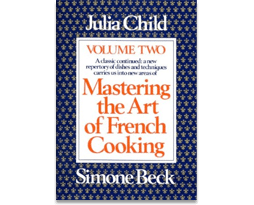
1970
With Julia complaining that “I need at least five more years to get this book right,” editor Judith Jones holds firm to the March deadline for the manuscript of Mastering the Art of French Cooking, Volume Two. Co-authored with Simone Beck, it is published in October.
-
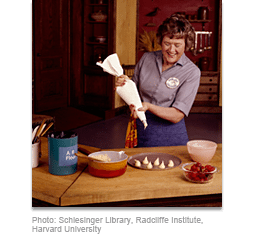
1970
A new The French Chef series debuts in color. The first season is described as “a tour of the French Classics, a refresher course for experienced cooks and a jet-assist take off for beginners.” The theme for the second season is “The French Chef Faces Life” – Julia shows viewers how to cope with situations that reflect the “demands of society,” such as family and getting kids involved in cooking, unexpected company, or a three-course sit-down dinner. In total, The French Chef series would span approximately 200 episodes.
-
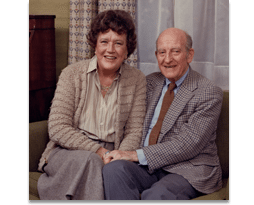
1974
Having noticed slight chest pains for several years, Paul is diagnosed as having blocked blood vessels. He undergoes a bypass, then a relatively new procedure that, perhaps from oxygen deprivation, leaves him with “mental scrambles.” Regardless, he is by Julia’s side constantly. In 1989, he suffers a series of strokes and Julia cuts back her work and travel schedule.
-
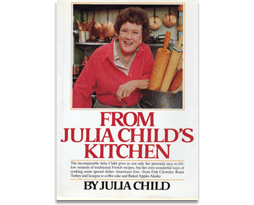
1975
From Julia Child’s Kitchen is published. The book is dedicated to the premise that “French cooking is simply good cooking” and contains all the recipes that were demonstrated on the second color series of The French Chef, while expanding, for the first time, into some popular American favorites.
-
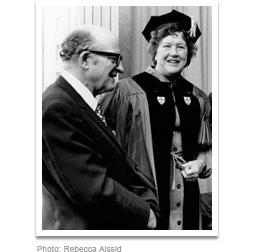
1976
Julia receives an Honorary Doctor of Humane Letters degree at Boston University’s May Commencement. It is one of more than ten honorary doctorates Julia will receive, including from Bates College, Brown University, Rutgers University, Smith College, and Harvard University – where her citation reads, “A Harvard friend and neighbor who has filled the air with common sense and uncommon scents. Long may her soufflés rise.”
-
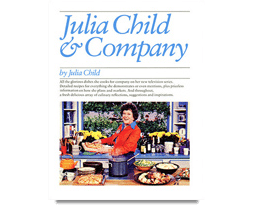
1978
Julia Child & Company airs on PBS for 13 episodes – a different show from the beginning. Julia and her team felt it was time to move away from purely French tradition so they created a beautiful new set and a series built around planning, shopping, cooking and presenting menus for everyday occasions. The companion book, Julia Child & Company, is published in 1978.
-
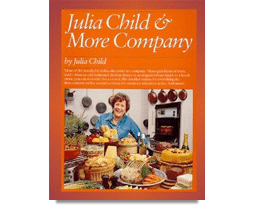
1979
Julia’s second cooking-for-company TV series, Julia Child & More Company, airs 13 episodes on PBS. Its companion book, Julia Child & More Company, is also published.
-
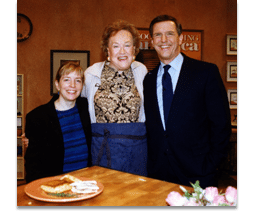
1980
Julia begins regular appearances on ABC’s Good Morning America, which continue through the ’80s. The three-minute segments would set the stage for a new era of cooking on television. In 1985, Julia traveled to Italy for GMA, filming a five-part series celebrating Italian food and culture, “Julia Child in Italy.” The series was so successful – ABC got letters from over 100,000 people – that it was aired again in 1987.
-
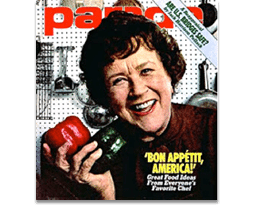
1982
Julia begins a monthly cooking column for Parade Magazine, which, says editor Judith Jones, was “perfect because it wasn’t elitist. Julia wanted to bring her message to the average home cook and make that person a better cook. She was able to reach people all over America.” She would continue the column through 1986.
-
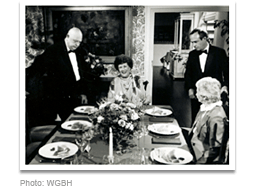
1983
Twenty years after the debut of The French Chef, Julia films Dinner at Julia’s. Each program includes a “gathering” sequence, filmed at various locations in California, in which Julia goes to the source for an ingredient. Each episode culminates around a dinner party hosted in Santa Barbara. Guest chefs attend, including James Beard. The show runs for 13 episodes on PBS.
-
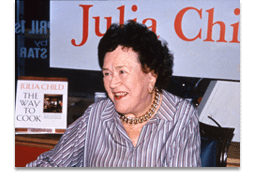
1989
Julia’s tome, The Way to Cook, which represents the accumulation of her French training and thirty years of cooking in America, is published. Editor Judith Jones explains, “Julia was always very open to new ideas, products, equipment, and attitudes and embraced the ones that she believed in. The Way to Cook is made up of so many of those influences. I did push her to make this book more personal than Mastering. It’s all Julia.”
-
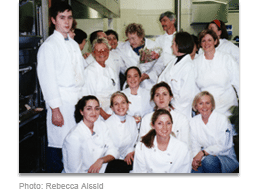
1991
Believing that the field of gastronomy is worthy of serious study, Julia and Jacques Pépin, chef and cookbook author, work with Boston University to launch a Master of Liberal Arts (MLA) degree in Gastronomy – a unique, multidisciplinary program that encompasses the arts, the humanities, and the natural and social sciences.
-
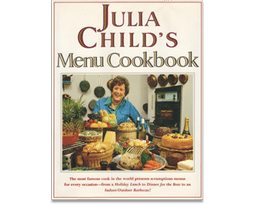
1991
Julia Child’s Menu Cookbook, combining the complete texts of Julia Child & Company and Julia Child & More Company, in hardcover, is published.
-
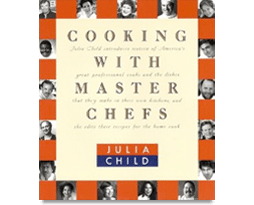
1993
Cooking with Master Chefs, which features Julia visiting celebrated chefs in their own kitchens throughout the country, airs on PBS. One of the 16 episodes, featuring Lidia Bastianich, is nominated for a 1994 Emmy Award. Other chefs include Emeril Lagasse, Jacques Pépin, and Alice Waters. Cooking with Master Chefs, companion book to the TV show, is published in 1993.
-
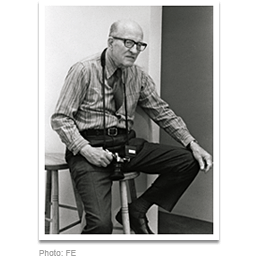
1994
May 12 – Wherever she was in the world, Julia would talk to Paul daily, setting her alarm so he would receive her call at the same time of day. In The French Chef Cookbook Julia credits “Paul Child, the man who is always there: porter, dishwasher, official photographer, mushroom dicer and onion chopper, editor, fish illustrator, manager, taster, idea man, resident poet, and husband.” The multi-talented Paul Child dies at age 92 in Lexington, MA.
-
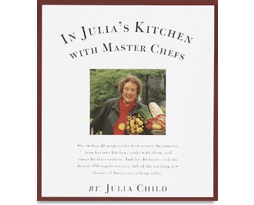
1994
In Julia’s Kitchen with Master Chefs airs on PBS. During the 39 episodes, Julia takes an in-depth look at contemporary American cooking alongside 26 chefs whom she invites into her Cambridge kitchen. In Julia’s Kitchen with Master Chefs, companion book to the TV show, is published in 1995.
-
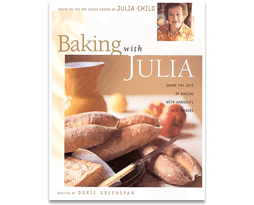
1996
Baking with Julia, featuring outstanding pastry chefs and bakers, teachers, and cookbook authors working with Julia, airs on PBS for 39 episodes. Baking with Julia, companion book to the TV show and written by Dorie Greenspan, is published in 1996.
-
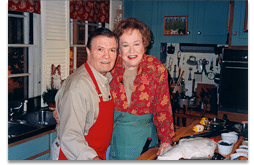
1999
Julia and Jacques Cooking at Home launches a 22-episode series on PBS. Julia and Jacques Cooking at Home, companion book to the TV show, is published in 1999. The show and the book are enormously popular due to Julia and Jacques’ chemistry as they present their cumulative cooking knowledge and a wide scope of techniques – about which they don’t always agree.
-
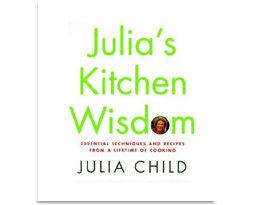
2000
Conceived of as an essential compendium of Julia’s wisdom and learning over the last forty years, Julia’s Kitchen Wisdom is published. “It began as my loose-leaf kitchen reference guide, gradually compiled from my own trials, remedies, and errors – corrected as I’ve cooked my way through the years,” she describes. Arranged according to type of ingredient with an emphasis on technique, the little volume is highly acclaimed. A two-hour special, Julia’s Kitchen Wisdom, airs on PBS.
-
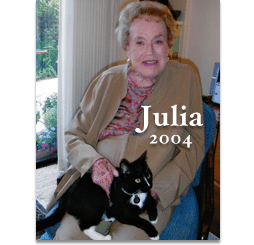
2004
August 13 – Julia dies of kidney failure two days before her 92nd birthday in Montecito, California.
View Julia’s memorial which appeared in Saveur Magazine.
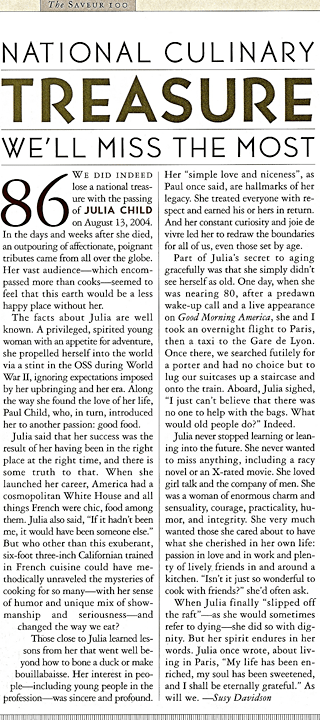
-
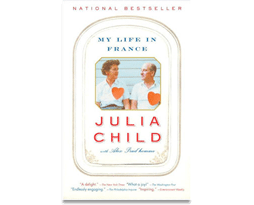
2006
Julia’s memoir, My Life in France, co-written with her grandnephew, Alex Prud’homme, is published. The book spans her childhood through the years she spent living with Paul in France and Europe, learning how to cook and publishing Mastering the Art of French Cooking. Julia ends the book with…”And thinking back on it now reminds me that the pleasures of the table, and of life, are infinite – toujours bon appétit!”
-
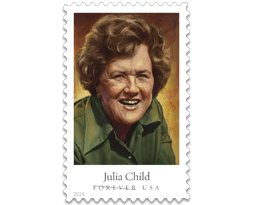
2014
The U.S. Postal Service® honors Julia’s legacy along with four other revolutionary chefs with the release of the limited-edition Celebrity Chefs Forever® stamps. The other chefs featured are James Beard, Joyce Chen, Edna Lewis and Felipe Rojas-Lombardi. “Seeing cooking as a source of delight, they invited us to feast on regional and international flavors and were early but ardent champions of trends that many foodies now take for granted. As they shared their know-how, they encouraged us to undertake our own culinary adventures” – USPS.com
-
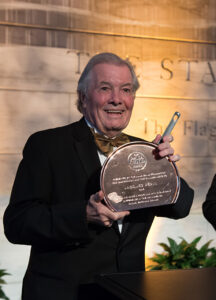
2015
Created by the Foundation, the Julia Child Award is given to an individual (or team!) who has made a profound and significant difference in the way America cooks, eats and drinks. The Foundation presents the annual Award in association with the Smithsonian’s National Museum of American History. Each year, the recipient receives a uniquely designed award, inspired by Julia’s collection of copper pots, and engraved with his or her name. In addition, the Foundation makes a $50,000 grant to the food-related non-profit organization of the recipient’s choosing.
-
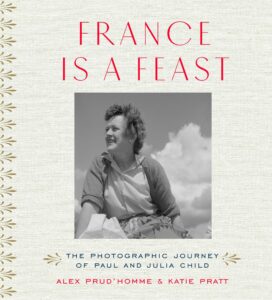
2017
October 24 – France is a Feast: The Photographic Journey of Julia and Paul Childby Alex Prud’homme and Katie Pratt is published by Thames & Hudson. Along with 250 black and white photographs taken by Julia’s husband, Paul, the book features personal stories recounted by Julia’s grandnephew Alex Prud’homme. Following the release of France is a Feast, the Napa Valley Museum Yountville launched a companion exhibit featuring framed prints and giant life-size blow-ups of Paul’s photos of Julia and Paul’s time in France. It was the most well-attended exhibit in the museum’s history.
-
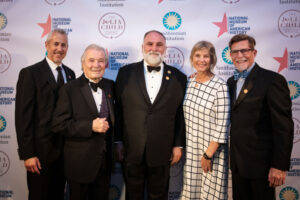
2019
November 7 – When José Andrés received the Julia Child Award in 2019, the Foundation celebrated the Award’s fifth anniversary at a gala event held at the Smithsonian’s National Museum of American History in Washington, D.C., and was joined by previous recipients Jacques Pépin (2015), Rick Bayless (2016), Danny Meyer (2017) and Mary Sue Milliken (2018). Since then, Danielle Nierenberg (2020) and Toni Tipton-Martin (2021) have received the Award. (Not pictured: Susan Feniger, 2018 co-recipient).
-
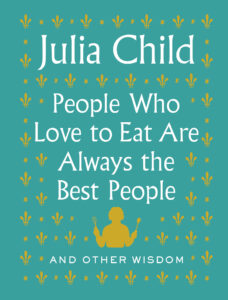
2020
November 17 – People Who Love to Eat Are Always the Best People , the first-ever collection of Julia’s verified quotes on food, wine, France, travel, love and life, is released by her long-time publisher A.A. Knop.
-
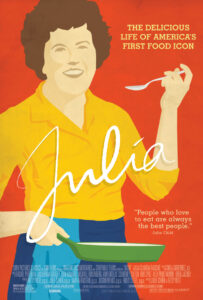
2021
November 12 – Julia: The Delicious Life of America’s First Food Icon, the first feature-length documentary dedicated to Julia’s life and work, hits theaters. Directed by Oscar-nominated filmmakers Julie Cohen and Betsy West, Julia features never-before-seen archival footage, personal photos and first-person narratives from the likes of José Andrés, Marcus Samuelsson and Alex Prud’homme, Julia’s grandnephew and co-author of her memoir, My Life in France.
-
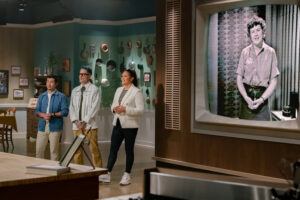
2022
March 14 – The Julia Child Challenge, featuring Julia superfans competing for the opportunity to follow in Julia’s footsteps with an all-expense paid three-month cooking course at Le Cordon Bleu, premieres on Food Network and streams on Discovery+. With Julia herself appearing through a larger-than-life television screen, the home cooks demonstrate their skills and passion in a kitchen recreated in the likeness of Julia’s own, and are judged by Antonia Lofaso, and a team of guest judges including Dorie Greenspan, Jacques Pépin, Molly Baz and Francis Lam.
-
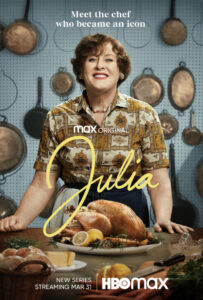
2022
March 31 – Julia, a scripted series inspired by Julia Child’s extraordinary life and her long-running television series, The French Chef, , which pioneered the modern cooking show, premieres on HBO Max. The series stars Sarah Lancashire as Julia and David Hyde Pierce as her husband, Paul, alongside Bebe Neuwirth, Brittany Bradford, Fran Kranz and Fiona Glascott, and features Isabella Rosselini, Judith Light and James Cromwell.
